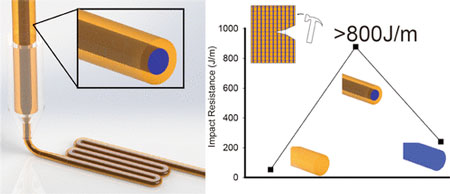| May 02, 2018 |
Improving 3-D printing of plastic parts
|
|
(Nanowerk News) Robots that can build homes, marathoners' running shoes and NASA's upcoming spacecraft all have one thing in common: 3-D printed parts. But as enthusiasm for 3-D printing continues to grow and expand across markets, the objects printed by the process can have weaknesses.
|
|
Now, one group reports in ACS Applied Materials & Interfaces ("Enhanced Impact Resistance of Three-Dimensional-Printed Parts with Structured Filaments") that using a simple modification to the manufacture of the starting materials improves the toughness of these printable plastics.
|
 |
| Net-shape manufacture of customizable objects through three-dimensional (3D) printing offers tremendous promise for personalization to improve the fit, performance, and comfort associated with devices and tools used in our daily lives. However, the application of 3D printing in structural objects has been limited by their poor mechanical performance that manifests from the layer-by-layer process by which the part is produced. Here, this interfacial weakness is overcome using a structured, core–shell polymer filament where a polycarbonate (PC) core solidifies quickly to define the shape, whereas an olefin ionomer shell contains functionality (crystallinity and ionic) that strengthen the interface between the printed layers. (© ACS)
|
|
As the 3-D printing market not only expands but also becomes more affordable, it is finding applications in many different areas. But this versatility is limited by the strength and durability of the printed parts. Most of these objects are printed in layers, which inherently results in weak spots where the layers meet. Thus, 3-D printed objects are not as strong as those made with current methods in which plastics are injected into molds.
|
|
To create stronger 3-D printed parts, Miko Cakmak, Bryan D. Vogt and colleagues wanted to explore whether the starting materials could be changed to self-reinforce the printed parts.
|
|
The researchers made a structured, core-shell polymer filament in which a polycarbonate core acts as a stiff skeleton to support and reinforce the 3-D printed shape. An olefin ionomer shell around the polycarbonate core improves and strengthens the connection between the printed layers.
|
|
During testing, printed parts with the filaments could withstand impacts without cracking, unlike parts made without them. The new filaments bring 3-D printed parts closer to the strength of parts manufactured by current methods.
|

